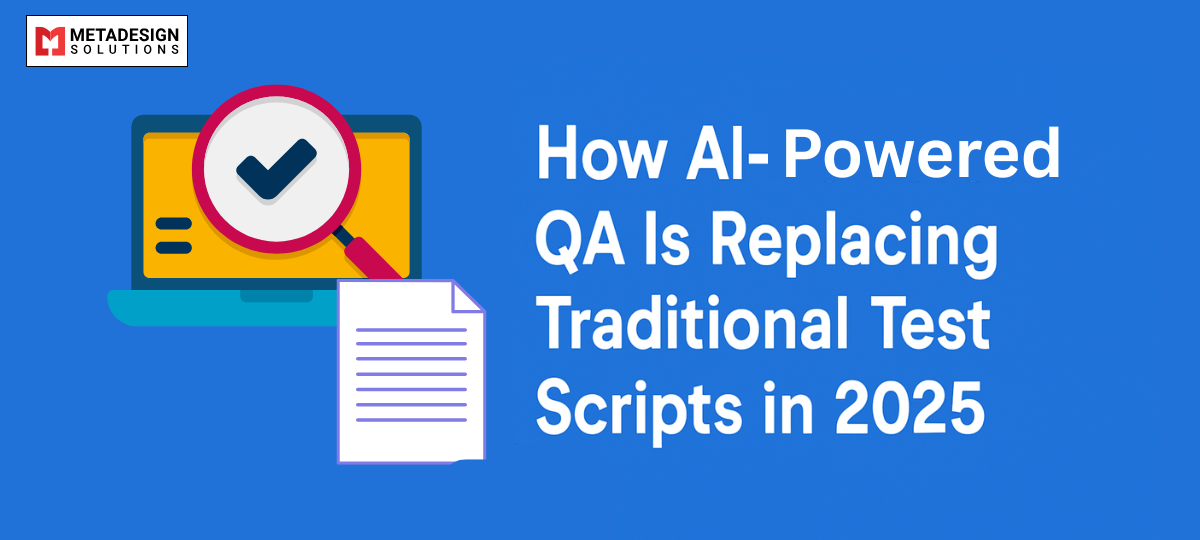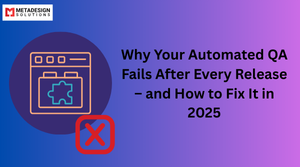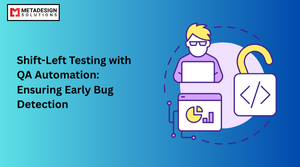Introduction: The Shift in QA Automation
In 2025, the quality assurance (QA) industry is experiencing a monumental shift. Traditional QA practices that once relied heavily on manual testing and scripted test cases are being replaced by AI-powered automation. While traditional testing scripts have served well in the past, their limitations have become more evident as software complexity and the demand for faster releases have increased.
To stay competitive, many organizations are enhancing their QA Software Testing Services by integrating AI-driven tools and intelligent automation frameworks. This evolution empowers QA teams to streamline processes, reduce testing time, and increase test coverage without compromising accuracy.
AI’s ability to learn from past data, predict issues, and adapt to changes has made it a game-changer for automated testing. The adoption of AI tools enables teams to overcome the constraints of traditional testing, such as slow feedback loops, human errors, and high maintenance costs.
This shift represents more than just a technological upgrade—it’s a transformation in how we approach software quality, with AI helping to ensure more reliable, scalable, and efficient testing practices.
Understanding Traditional Test Scripts
Before we dive into the benefits of AI-powered testing, let’s first understand traditional test scripts and why they are being gradually replaced.
What Are Traditional Test Scripts?
Traditional test scripts are predefined sets of instructions that testers follow to check if a software application performs as expected. These scripts are typically created manually and include a series of actions that simulate user behavior, such as clicking buttons, entering text, or navigating through different features of the application.
Once the script is executed, the tester verifies if the application’s response matches the expected outcome. The primary advantage of this approach is its simplicity and predictability, but there are several challenges associated with maintaining these scripts.
Common Challenges with Maintaining and Scaling Traditional Test Scripts
- High Maintenance Overhead: As applications evolve with each release, test scripts must be constantly updated to reflect changes in the UI, features, or logic. This makes them time-consuming and costly to maintain.
- Limited Flexibility: Traditional scripts are static and do not easily adapt to dynamic application changes. Minor updates to the app may require rewriting large portions of test cases.
- Scalability Issues: As the complexity of an application grows, it becomes harder to scale manual test scripts to cover all use cases, leading to gaps in test coverage.
- Human Error: Since traditional tests require manual execution, there’s always a risk of human error, which can lead to missed bugs or false negatives.
How AI is Transforming QA Automation
With AI in QA, the testing landscape is rapidly changing. Artificial intelligence (AI) enables machines to simulate human intelligence, allowing for self-learning and adaptation. In QA automation, AI can be leveraged to analyze patterns, predict bugs, and enhance testing coverage.
The Role of AI in Modern QA
AI-driven QA tools learn from historical test data and continuously improve their ability to detect issues. This is far more efficient than traditional test scripts, where changes in the application often necessitate the manual rewriting of test cases. AI systems can be trained to understand the behavior of an application and can automatically generate new test cases based on this learned behavior.
By using machine learning (ML) algorithms, AI tools can make predictive analyses to identify areas most likely to fail, allowing for focused and effective testing.
How AI Can Adapt to Changes in the Application Dynamically
One of the key benefits of AI-powered QA is its ability to dynamically adapt to changes in an application. Unlike traditional scripts that require manual updates when new features or changes are introduced, AI tools can update themselves based on the input data they receive.
For example, if a new feature is added to an app, AI-driven tools can automatically adjust the test scenarios to include this new feature, ensuring that it is tested without requiring manual intervention.
AI-Powered Testing Services
Looking to enhance efficiency and reduce manual efforts in your QA processes? Book a meeting with MDS to implement AI-powered testing frameworks that streamline your workflows.
AI-Powered Testing Tools
The AI-powered testing landscape is evolving rapidly, with new tools and frameworks emerging to meet the demands of modern software development. Let’s look at some of the top AI-driven testing tools and how they are changing the way QA works.
Introduction to AI-Based Testing Tools and Platforms
AI-powered testing tools use various AI and machine learning techniques to improve automation. These tools are designed to reduce manual effort, improve testing accuracy, and enhance test coverage.
Examples of popular AI-driven QA tools include:
- Testim.io: Uses AI to automatically generate and execute test scripts, continuously improving the test quality as the application evolves.
- Applitools: Focuses on visual testing and uses AI to identify visual regressions across different devices and screen sizes.
- Functionize: Uses machine learning to create intelligent test cases that adapt to changing applications without the need for constant updates.
These tools analyze data from previous tests, use predictive analytics to identify problem areas, and can even automatically fix failing tests, ensuring a more robust and scalable testing process.
Examples of AI-Driven QA Tools and How They Work
- Testim.io: This tool uses AI to automatically generate test cases based on the user interface (UI). When an application is updated, Testim.io’s AI adapts the tests, reducing the need for manual intervention. Its machine learning capabilities allow it to learn from test results, improving test accuracy over time.
- Applitools: Known for visual AI testing, Applitools uses machine learning to detect visual differences between the application’s design and expected outcomes. It helps teams ensure that user interfaces are consistent across devices and screen resolutions.
- Functionize: This platform combines machine learning and natural language processing to generate intelligent test cases. Functionize can analyze the application and suggest tests for various use cases, allowing developers to focus on coding rather than test creation.
These AI-powered tools help teams reduce test creation time, increase efficiency, and improve the overall quality of their applications.
Benefits of AI-Powered QA Over Traditional Scripts
AI-powered QA offers several advantages over traditional test scripts, making it an essential part of modern software development.
Speed and Efficiency Improvements
AI can perform tests at much faster speeds compared to manual testing. With AI tools, developers can run automated tests more frequently and receive feedback in real-time, which accelerates the software development lifecycle. Additionally, AI-driven testing reduces the time spent on manual intervention, freeing up resources to focus on more critical tasks.
Reduced Human Error and Improved Accuracy
AI-powered testing minimizes human errors, which are common in manual testing. By removing the possibility of human oversight, AI ensures that tests are executed with precision and accuracy, leading to more reliable results.
Moreover, AI tools learn from past results, improving their ability to identify issues in future tests and reducing the likelihood of false positives or negatives.
Scalability and Adaptability in Testing
As your application grows, the need for scalable test automation increases. Traditional scripts require constant updates to accommodate new features, but AI tools can adapt to these changes automatically. This scalability ensures that as your application becomes more complex, your testing efforts can keep pace without requiring additional resources.
How AI Can Improve Test Coverage and Accuracy
One of the significant advantages of AI in QA is its ability to improve test coverage and accuracy.
AI’s Ability to Test Beyond the Usual Scripts
AI can analyze the entire application and generate test cases for scenarios that may not have been considered in traditional scripts. For example, AI tools can identify edge cases or rare conditions that might be missed by static scripts, ensuring that all potential failure points are covered.
Identifying Edge Cases and Unusual Scenarios
AI excels at identifying edge cases—uncommon or unexpected situations that may break the application. These edge cases are often overlooked in traditional testing because they require human intuition and deep knowledge of the system’s potential vulnerabilities. AI can discover these rare scenarios and generate tests specifically designed to ensure the system handles them appropriately.
Challenges in Implementing AI-Powered QA
Despite the significant advantages, adopting AI-powered QA tools comes with its own set of challenges. Organizations looking to transition from traditional test scripts to AI-driven testing must be aware of these obstacles and plan for their resolution.
Integration with Existing CI/CD Pipelines
One of the main challenges when adopting AI-powered testing tools is integration with existing Continuous Integration/Continuous Deployment (CI/CD) pipelines. CI/CD workflows are essential for ensuring that code changes are automatically tested and deployed. AI-powered testing tools must be integrated into these pipelines seamlessly to ensure that automated tests run as part of the deployment cycle.
The integration process often requires configuration changes, the setup of new environments, and modifications to existing workflows. In some cases, additional tools may be required to connect AI-driven testing with the pipeline, which can add complexity.
Training AI Models and Handling False Positives/Negatives
AI tools require training to be effective. This involves feeding the system with historical test data to allow the tool to learn patterns, predict outcomes, and identify bugs. The challenge is ensuring that the AI model is trained properly to generate accurate test cases and not create unnecessary tests based on flawed data.
Additionally, AI models are not perfect, and there’s a risk of false positives (incorrectly identifying issues where there are none) or false negatives (failing to detect real issues). To handle this, organizations need to invest in ongoing model training and fine-tuning.
Costs and Resource Requirements for AI Adoption
While AI-powered QA tools offer significant long-term benefits, the initial costs and resource requirements can be a barrier for some organizations. Training the AI models, implementing AI tools, and maintaining them over time requires investment in both financial resources and skilled personnel.
Moreover, the transition from traditional QA practices to AI-powered testing may require teams to acquire new skills and undergo training. As the technology matures, however, the costs associated with AI tools are expected to decrease, making them more accessible to smaller organizations.
Best Practices for Implementing AI in QA
To ensure a smooth transition to AI-powered QA, it’s important to follow best practices that help organizations successfully integrate AI into their QA workflows.
Steps to Successfully Integrate AI into Your QA Workflow
- Assess Your Current QA Processes: Before adopting AI tools, organizations should assess their existing QA processes and identify areas where AI can add value. This includes identifying bottlenecks, repetitive tasks, and areas that need improvement.
- Choose the Right AI Tools: There are many AI-powered QA tools available on the market. It’s important to select one that fits the specific needs of your organization. Consider factors such as ease of integration, customization options, and support for the platforms you use.
- Train Your Team: AI tools require a learning curve. It’s important to train your QA team on how to use the tools effectively. This may involve formal training sessions or hiring consultants with expertise in AI-powered testing.
- Start Small: Begin with a pilot project to implement AI-powered testing on a small scale. This allows you to test the tool’s capabilities, identify potential issues, and fine-tune your processes before scaling to larger projects.
- Monitor and Iterate: After implementation, continuously monitor the performance of AI-powered testing and collect feedback from the team. Use this feedback to make adjustments and improve the AI models over time.
Managing the Transition from Traditional to AI-Powered Testing
Switching from traditional test scripts to AI-powered testing doesn’t happen overnight. Organizations should follow a gradual transition plan to ensure that the existing testing processes continue to run smoothly during the changeover. This may involve running both traditional and AI-based tests in parallel, with the goal of phasing out the old process over time.
Additionally, it’s important to maintain a collaborative approach throughout the transition. Developers, testers, and QA teams should work together to ensure the successful integration of AI-powered testing into the workflow.
The Future of AI in QA: What’s Next?
AI in QA is still in its early stages, but the potential for growth and innovation is enormous. As AI technologies continue to evolve, we can expect significant advancements that will further shape the future of automated testing.
How AI Will Evolve in QA Automation
In the coming years, AI-powered QA tools will become even more intelligent and autonomous. Machine learning algorithms will continue to improve, allowing AI systems to detect even more complex bugs and issues. Additionally, natural language processing (NLP) technologies will make it easier for testers to interact with AI systems using natural language, reducing the need for technical expertise.
AI will also play a role in predictive analytics, allowing teams to identify potential failures before they occur. This proactive approach will enable teams to address issues early in the development cycle, reducing the risk of costly bugs making it into production.
Upcoming Trends and Innovations in AI Testing
- Automated Test Case Generation: AI will be able to generate test cases automatically based on application behavior. This will reduce the need for manual intervention and allow teams to focus on other critical aspects of testing.
- Smarter Test Maintenance: AI tools will be able to automatically detect changes in the application and adjust existing test cases accordingly, further reducing maintenance overhead.
- Cross-Platform Testing: AI will enable seamless testing across multiple platforms and devices, ensuring that applications work consistently regardless of where they are run.
- Self-Healing Tests: In the near future, AI-powered testing tools may have the ability to “self-heal” broken tests. If a test fails due to an unexpected change in the application, the AI system could automatically fix the test to ensure it continues to run smoothly.
Conclusion
AI-powered QA is undoubtedly changing the landscape of software testing in 2025. By replacing traditional test scripts with AI-driven Automated QA, organizations can enhance their testing efforts, reduce human error, and improve overall software quality. This evolution allows teams to scale their testing processes while maintaining speed and accuracy.
While challenges remain, such as integration with existing systems and the costs of adoption, the long-term benefits of AI-powered and Automated QA are clear.
As AI continues to evolve, we can expect more intelligent, adaptive, and efficient testing tools that will help organizations deliver better software faster. The future of QA lies in AI, and those who embrace it will be well-equipped to keep up with the rapidly changing world of software development.
Related Hashtags:
#AutomatedQA #QAAutomation #QACompany #SoftwareTesting #QAServices #CI_CD #QATestingTools #MachineLearningQA #QA2025 #DevOps #AgileTesting #AIinQA #QAAutomationCompany #SoftwareQuality #QASoftwareTestingServices #QAAutomationTestingServices #SoftwareQATestingAndAutomationCompany #QAAutomationCompany



